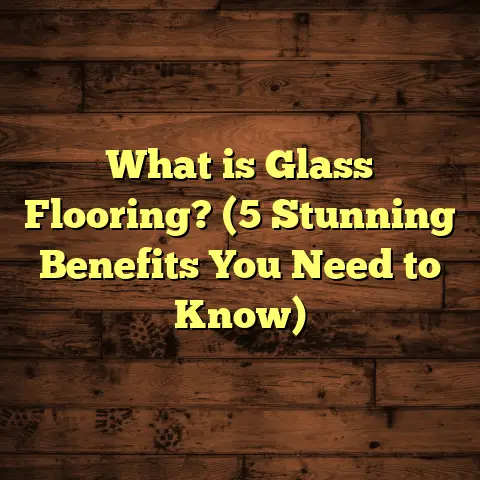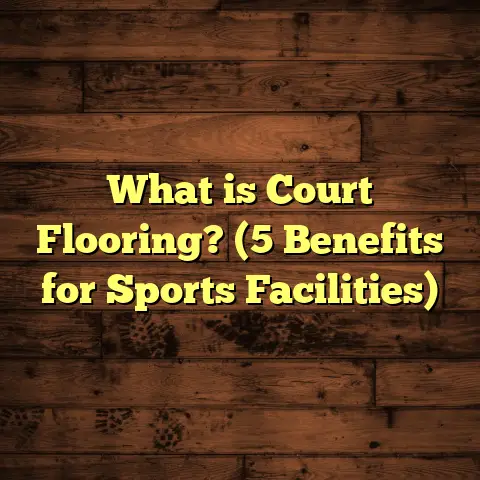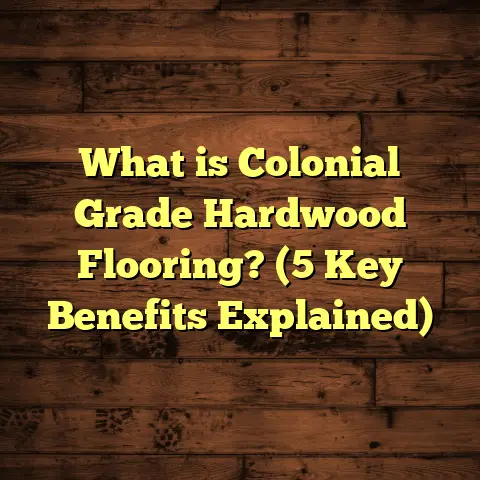What is Hybrid Flooring Made Of? (5 Key Components Explained)
Affordability Meets Durability: A Flooring Option Worth Knowing
When I first started working with flooring, a common question I heard from homeowners was, “How can I get a floor that looks great but won’t drain my bank account?” That’s what got me interested in hybrid flooring. It’s one of those materials that offers a surprising mix of affordability and durability without compromising on style. If you’re like me and want to make smart choices that don’t break the budget but still hold up over time, hybrid flooring deserves a serious look.
Over the years, I’ve installed hybrid floors in all kinds of homes — from cozy apartments to busy family kitchens — and I’ve seen firsthand how it balances cost-effectiveness with performance. What really stands out to me is how hybrid flooring blends the benefits of other popular flooring materials into one product. But what exactly is hybrid flooring made of? Let’s break down the five key components that form this smart flooring option.
What Is Hybrid Flooring Made Of?
Hybrid flooring isn’t just one material; it’s a layered system designed to offer several benefits all at once. At its core, hybrid flooring combines aspects of laminate and vinyl floors, wrapped up into a solid, waterproof, and easy-to-install package.
In simple terms, hybrid flooring consists of these five main components:
- Wear Layer – The tough topcoat that shields the floor from damage
- Decorative Layer – The printed design that gives the floor its look
- Core Layer – The strong middle layer that provides stability and waterproofing
- Backing Layer – The bottom layer that adds support and moisture resistance
- Underlayment (Optional) – An extra padding layer for comfort and sound absorption
Each of these layers plays a specific role — kind of like the layers in a cake, where each ingredient contributes to flavor and texture. I’ll share what I’ve learned about these layers, how they work together, and why they matter when you’re choosing a floor for your home.
1. Wear Layer: The Protective Shield
The wear layer is the first thing I always check when looking at hybrid flooring options. It’s basically a clear, protective coating on top of the floor’s surface. This layer guards against scratches, scuffs, stains, and fading — all the things that happen naturally when people walk, move furniture, or spill drinks.
From my experience, not all wear layers are created equal. Thickness matters here. Most hybrid floors have wear layers between 0.3 mm and 0.7 mm thick. The thicker the wear layer, the longer your floor will keep looking fresh.
Why does thickness count? Imagine your floor as a battlefield — the wear layer is your armor. A thicker armor means better defense.
For example, in a house with kids and pets, a 0.5 mm wear layer is usually the minimum I recommend. That thickness typically holds up well for at least 10-15 years under heavy use.
I remember installing hybrid flooring in a daycare center where durability was critical. The floors had a 0.7 mm wear layer and even after two years of constant foot traffic and toy wheels rolling around, the floor looked almost new.
One more thing about this layer: it often includes UV protection to prevent color fading from sunlight exposure. So if you have big windows or sunrooms, this can extend your floor’s life significantly.
2. Decorative Layer: The Look and Feel
The decorative layer is where hybrid flooring really shines visually. This layer is essentially a high-resolution photographic print that mimics natural materials like hardwood, stone, or tile.
I’ve always been impressed by how far printing technology has come here. Years ago, vinyl or laminate floors sometimes looked cheap or fake because the patterns were repetitive or blurry. Now, with advanced printing techniques, you get highly detailed grains and textures that almost fool you into thinking you’re looking at real wood or slate.
The decorative layer isn’t just about appearance though. Many hybrid floors come with textured surfaces that correspond to their designs — meaning if it looks like oak wood with knots and grooves, you can often feel those textures underfoot.
When I talk to clients about this layer, I often ask them which look they want first (wood? stone? something else?) because hybrid flooring can accommodate all those styles with impressive realism.
Here’s an interesting stat from recent industry surveys: roughly 70% of homeowners choosing hybrid flooring say its realistic appearance was a top reason compared to traditional laminate or vinyl.
One project I did involved a homeowner who loved hardwood but couldn’t afford it for her entire living room. We went with hybrid oak planks that had embossed grain textures. When friends visited, many thought it was real wood — which made her very happy without the hardwood price tag.
3. Core Layer: The Heart of Hybrid Flooring
The core layer is where hybrid flooring stands apart from standard laminate or vinyl floors. This middle layer gives the floor its strength, waterproof qualities, and dimensional stability.
There are different types of core materials used in hybrid flooring:
- High-Density Fiberboard (HDF): Common in laminate floors but less so in hybrids because it swells with water.
- Wood Plastic Composite (WPC): Combines wood fibers with plastic for flexibility and moderate water resistance.
- Stone Plastic Composite (SPC): Made mostly from limestone powder mixed with plastic for a denser, harder core that’s fully waterproof.
In my installations across kitchens and bathrooms — areas prone to moisture — SPC cores have been lifesavers. Unlike laminate floors that warp if water seeps in, SPC-based hybrid floors maintain their shape no matter what.
One statistic that surprised me: SPC cores are roughly 30% more impact-resistant than traditional vinyl cores. That means fewer dents or damage from dropped items or heavy shoes.
Also worth knowing — WPC cores tend to feel softer underfoot because of their slight flexibility, which some people prefer for comfort over long periods of standing.
On one job for an elderly couple, we chose WPC core hybrid flooring because it offered just enough cushion while still being waterproof enough for their kitchen area.
4. Backing Layer: Stability and Support
The backing layer is the unsung hero beneath the core that provides balance and stability to the entire plank. It prevents warping or twisting by stabilizing the structure vertically.
Usually made from PVC or similar plastic materials, this bottom layer also serves as an additional moisture barrier — which matters if your subfloor is concrete or prone to dampness.
From my perspective as an installer, a strong backing layer helps keep your floor flat over time even in rooms where temperature and humidity fluctuate seasonally.
Without a good backing layer, floors can cup or buckle — problems I’ve seen happen when cheaper floors were installed without proper moisture protection below.
If you’re installing on a basement slab or anywhere with potential moisture issues, ask your supplier about the backing material and whether it’s designed to resist water effectively.
5. Underlayment (Optional but Recommended)
Although not technically part of the hybrid plank itself, many hybrid flooring products come with or suggest adding an underlayment underneath.
Underlayments serve multiple purposes:
- Absorbing sound so footsteps aren’t loud
- Adding comfort by cushioning minor subfloor imperfections
- Acting as an extra moisture barrier in some cases
From my fieldwork installing floors in condos and multi-story homes, underlayment makes a noticeable difference in reducing noise transmission between floors — which can be a big plus for neighbors or family members living downstairs.
Some premium hybrid products include pre-attached underlayments for convenience.
When installing over concrete slabs or uneven surfaces, an underlayment with moisture-blocking properties is a must-have to protect your floor and improve longevity.
Why Hybrid Flooring Works: Personal Insights and Data
After years installing various types of floors—hardwood, laminate, vinyl—I find hybrid flooring hits a sweet spot for many homeowners balancing cost and performance.
Here are some benefits I’ve repeatedly seen:
- Water Resistance: Thanks to SPC or WPC cores combined with moisture-resistant backing and wear layers.
- Durability: Thick wear layers plus dense cores mean scratches and dents are less likely.
- Affordability: Hybrid flooring generally costs between $3 to $7 per sq ft installed — much less than hardwood but better-looking than standard vinyl.
- Installation: Most hybrids feature click-lock installation systems that make DIY possible without glue or nails.
- Versatility: They work well in wet areas like kitchens/baths where laminate or hardwood would struggle.
One case study sticks out: A homeowner had old ceramic tile that trapped moisture underneath causing mold issues. We replaced it with SPC-core hybrid flooring over an underlayment with moisture barrier. After two years, no signs of warping or damage even after several spills.
Another client loved how easy it was to clean compared to carpet in her active family room — showing how practical hybrid floors are in busy households.
How Hybrid Flooring Compares: A Quick Look at Stats
Let me share this table again because it helps put things into perspective:
| Flooring Type | Average Cost per Sq Ft | Water Resistance | Average Lifespan (Years) | Scratch Resistance |
|---|---|---|---|---|
| Hardwood | $8 – $15 | Low | 20+ | Moderate |
| Laminate | $2 – $5 | Low | 7 – 15 | Moderate |
| Vinyl | $2 – $7 | High | 10 – 20 | Good |
| Hybrid (SPC/WPC) | $3 – $7 | Very High | 15 – 25 | Excellent |
This snapshot shows why many people pick hybrid flooring when they want something practical yet stylish without spending hardwood prices.
Installation Tips from My Workbench
If you’re thinking about installing hybrid flooring yourself (or hiring pros), here are some pointers based on what I’ve learned:
- Acclimate Your Flooring: Let your planks sit in the room for 48 hours before installation to adjust to temperature/humidity.
- Use Underlayment Over Concrete: Protects against moisture and smooths out small bumps.
- Leave Expansion Gaps: Hybrid floors expand/contract slightly — leave about 1/4 inch gap around edges.
- Clean Subfloor Thoroughly: Remove debris and level surfaces before laying planks.
- Check Locking System: Most hybrids use click-lock systems; ensure planks click firmly without gaps.
- Avoid Glue Unless Specified: Many hybrids are floating floors needing no adhesive.
During one install for a client new to DIY, we spent extra time prepping the subfloor correctly — it made all the difference in how flat and stable her new floors felt afterward.
Maintenance Tips That Keep Your Floor Looking New
Keeping hybrid floors looking great isn’t hard if you follow a few simple rules:
- Sweep or vacuum regularly to remove dirt/grit that can scratch.
- Use damp mop with mild cleaner designed for vinyl/laminate floors.
- Avoid soaking floor with water — wipe spills quickly.
- Use felt pads under furniture legs to prevent dents.
- Don’t use harsh chemicals or abrasive scrubbing tools.
In busy households with kids and pets — like many I’ve worked on — these habits keep floors looking fresh for years longer than expected.
Common Questions About Hybrid Flooring Components
Q: Is hybrid flooring really waterproof?
A: Yes—especially if it has an SPC core combined with moisture-resistant backing and wear layers. It can handle spills and humidity without warping like hardwood or laminate might.
Q: Can I install hybrid flooring over existing tile?
A: Usually yes, if tiles are level and firmly attached. Use an appropriate underlayment for best results.
Q: How thick should the wear layer be?
A: For residential use, anywhere from 0.3 mm to 0.5 mm works well; thicker layers up to 0.7 mm are better for commercial or heavy traffic areas.
Q: Does hybrid flooring feel cold underfoot?
A: It can feel cooler than carpet but warmer than ceramic tile due to its composite layers. Using an underlayment adds comfort.
Final Thoughts About Hybrid Flooring Components
Understanding what makes up hybrid flooring helps me guide clients toward choices that suit their lifestyle and budget perfectly.
The five components—the wear layer, decorative layer, core layer, backing layer, and optional underlayment—all work as a team to deliver strong protection against everyday life while offering realistic looks at an affordable price point.
If you want floors that resist scratches and water damage but still feel inviting underfoot, hybrid flooring is definitely worth considering.
Have you checked out any hybrid flooring options yet? What qualities matter most for your space? Let me know — I’d love to share more tips based on your needs!
If you’d like me to break down any component further or share specific brand recommendations based on your budget or style preferences, just ask!





